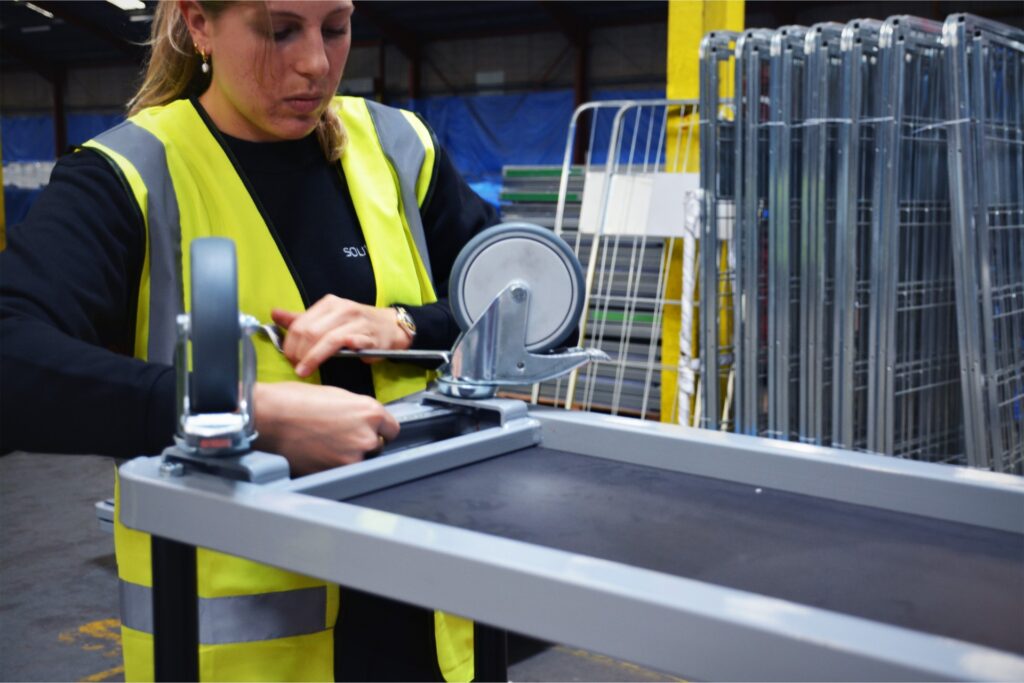Southgate Global, a leading specialist in equipment servicing, is helping organisations operating in waste management cut costs and their carbon footprint. Southgate’s White Paper outlines the benefits of repairing instead of replacing key equipment used in transporting bins, waste sacks and recyclable materials across facilities.
In 2024, the global waste management market size was valued at $1,396.28 billion, and is expected to continue to grow to be worth an estimated $2,357.82 billion in ten years’ time.[1] As the sector expands, it faces increasing issues such as stricter environmental legislation, growth in the volume of waste being generated and rising operational costs. It is now more important than ever for organisations to assess how they can streamline operations and reduce downtime to meet these new pressures.
With waste management equipment subject to frequent collisions, rough handling, extended use across different floor surfaces and heavy loads, equipment is at high risk of damage, causing unexpected downtime and reduced efficiencies. Recognising this, Southgate Global’s White Paper is helping organisations understand when to repair instead of replace damaged equipment, and the importance regular servicing plays in pre-empting equipment failure.
Last year alone, Southgate repaired more than 200,000 carts and trolleys that would otherwise have been written off, helping its customers extend the life of their equipment, minimising downtime, and substantially reducing their CAPEX. Its repair-first maintenance programme also created £40 million of CAPEX savings in a single year for one customer and made a real contribution to that customer’s sustainability targets.
This is the latest in a series of industry-leading White Papers produced by Southgate aimed at helping businesses create a more resilient and cost-effective operation. It sets out the seven key benefits of repairing equipment, a checklist process for organisations to use, and provides a calculator to enable businesses to work out when repairing is the most cost-effective option over replacement.
Titled ‘Repair or Replace? A Southgate Global White Paper on the ESG and CAPEX Advantages of Extending Equipment Life’, the White Paper focuses on helping organisations identify when to repair or replace damaged parts. It also encourages them to think more broadly about the type of equipment that can be efficiently maintained and repaired, through heavy-duty servicing plans, regular inspections to pre-empt failure and proactive maintenance tailored to high-impact, high-usage environments provided by Southgate.
John Maher, Head of Fulfilment Servicing at Southgate Global, explains: “Carts and trolleys, indeed any manual handling equipment, are integral to every warehouse operation no matter the sector. But they’re often perceived as low value and as a result, are frequently replaced at the first sign of wear.
“There is a danger when taking this approach. Often the financial cumulative cost of replacements is not factored in. For example, replacing equipment incurs not only the capital cost of new assets but also additional expenses related to transportation, downtime and integration. Repairing damaged trolleys, either brakes, wheels or general servicing, is far more cost-effective than purchasing a whole new unit. We proved this to ourselves and our customers time and time again in all our calculations. With more than 40 expert technicians maintaining and repairing over 5,000 items of packing and material handling equipment each week across the UK and Europe we’re in a strong position to know.”
Within waste management, the frequent replacement of equipment not only adds to an organisation’s costs, but can also massively undermine its ESG (Environmental, Social, and Governance) commitments. Prioritising repairs over replacements helps to extend product lifecycles, minimise resource consumption and lower an organisation’s carbon footprint.
But Southgate Global recognises that there are times when replacement may be the more economical choice long term. Machinery and equipment can deteriorate to such a point where ongoing repairs can only provide a temporary solution, leading to mounting maintenance costs. Alongside this, older machinery and equipment often might run less efficiently, making a more energy-efficient replacement the better option long term.
In response to this, Southgate’s pioneering White Paper contains a checklist of factors to consider such as cost, the lifecycle stage of the equipment, the wider impact on overall operations and speed when deciding to repair or replace. It has also produced an industry-first equation which provides a structured approach to weighing the costs and benefits of repair versus replacement:
A (Value of extended asset life + Operational continuity benefits) – Total repair & maintenance cost =
£Value of repair
B Value of improved efficiency & reliability – Total replacement cost = £Value of replacement
If A is greater than B = Repair
If B is greater than A = Replace
Southgate’s experts are on hand to support in accessing and analysing the necessary data to input into the equation. Its team has the technical expertise to calculate the cost and value of repairing and renovating waste management equipment, but also the knowledge to assess the relative costs and benefits of replacing them with the latest models when more appropriate.
To download Southgate’s latest white paper to help reduce CAPEX and improve sustainability, click here.





















































